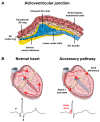How Cardiac Embryology Translates into Clinical Arrhythmias
- PMID: 34199178
- PMCID: PMC8231901
- DOI: 10.3390/jcdd8060070
How Cardiac Embryology Translates into Clinical Arrhythmias
Abstract
The electrophysiological signatures of the myocardium in cardiac structures, such as the atrioventricular node, pulmonary veins or the right ventricular outflow tract, are established during development by the spatial and temporal expression of transcription factors that guide expression of specific ion channels. Genome-wide association studies have shown that small variations in genetic regions are key to the expression of these transcription factors and thereby modulate the electrical function of the heart. Moreover, mutations in these factors are found in arrhythmogenic pathologies such as congenital atrioventricular block, as well as in specific forms of atrial fibrillation and ventricular tachycardia. In this review, we discuss the developmental origin of distinct electrophysiological structures in the heart and their involvement in cardiac arrhythmias.
Keywords: arrhythmias; cardiac development; re-entry; transcription factors.
Conflict of interest statement
The authors have no conflict of interest to declare.
Figures





Similar articles
-
Developmental basis for electrophysiological heterogeneity in the ventricular and outflow tract myocardium as a substrate for life-threatening ventricular arrhythmias.Circ Res. 2009 Jan 2;104(1):19-31. doi: 10.1161/CIRCRESAHA.108.188698. Circ Res. 2009. PMID: 19118284 Review.
-
Clinical observations of supraventricular arrhythmias in patients with brugada syndrome.Int J Clin Exp Med. 2015 Aug 15;8(8):14520-6. eCollection 2015. Int J Clin Exp Med. 2015. PMID: 26550443 Free PMC article.
-
[Ventricular pre-excitation: electrophysiopathology, criteria for interpretation and clinical diagnosis. References for geriatrics].Minerva Cardioangiol. 2001 Feb;49(1):47-73. Minerva Cardioangiol. 2001. PMID: 11279385 Review. Italian.
-
Arrhythmia surgery in association with complex congenital heart repairs excluding patients with fontan conversion.Semin Thorac Cardiovasc Surg Pediatr Card Surg Annu. 2003;6:33-50. doi: 10.1053/pcsu.2003.50019. Semin Thorac Cardiovasc Surg Pediatr Card Surg Annu. 2003. PMID: 12740770
-
Interventional electrophysiology and its role in the treatment of cardiac arrhythmia.Ann Acad Med Singap. 1998 Mar;27(2):248-54. Ann Acad Med Singap. 1998. PMID: 9663319 Review.
Cited by
-
Development of autonomic innervation at the venous pole of the heart: bridging the gap from mice to human.J Transl Med. 2025 Jan 15;23(1):73. doi: 10.1186/s12967-024-06049-y. J Transl Med. 2025. PMID: 39815264 Free PMC article.
-
Successful ablation of an outlet septum ventricular tachycardia in a double-outlet right ventricle patient who underwent an extracardiac Fontan operation.HeartRhythm Case Rep. 2022 Apr 29;8(8):543-547. doi: 10.1016/j.hrcr.2022.04.015. eCollection 2022 Aug. HeartRhythm Case Rep. 2022. PMID: 35996703 Free PMC article. No abstract available.
-
Inherited and Acquired Rhythm Disturbances in Sick Sinus Syndrome, Brugada Syndrome, and Atrial Fibrillation: Lessons from Preclinical Modeling.Cells. 2021 Nov 15;10(11):3175. doi: 10.3390/cells10113175. Cells. 2021. PMID: 34831398 Free PMC article. Review.
-
New Perspectives on Risk Stratification and Treatment in Patients with Atrial Fibrillation: An Analysis of Recent Contributions on the Journal of Cardiovascular Disease and Development.J Cardiovasc Dev Dis. 2023 Feb 2;10(2):61. doi: 10.3390/jcdd10020061. J Cardiovasc Dev Dis. 2023. PMID: 36826557 Free PMC article.
-
Echocardiography Imaging of the Right Ventricle: Focus on Three-Dimensional Echocardiography.Diagnostics (Basel). 2023 Jul 25;13(15):2470. doi: 10.3390/diagnostics13152470. Diagnostics (Basel). 2023. PMID: 37568832 Free PMC article. Review.
References
-
- Costantini D.L., Arruda E.P., Agarwal P., Kim K.H., Zhu Y., Zhu W., Lebel M., Cheng C.W., Park C.Y., Pierce S.A., et al. The homeodomain transcription factor Irx5 establishes the mouse cardiac ventricular repolarization gradient. Cell. 2005;123:347–358. doi: 10.1016/j.cell.2005.08.004. - DOI - PMC - PubMed
-
- Veerman C.C., Podliesna S., Tadros R., Lodder E.M., Mengarelli I., de Jonge B., Beekman L., Barc J., Wilders R., Wilde A.A.M.M., et al. The Brugada Syndrome Susceptibility Gene HEY2 Modulates Cardiac Transmural Ion Channel Patterning and Electrical Heterogeneity. Circ. Res. 2017;121:537–548. doi: 10.1161/CIRCRESAHA.117.310959. - DOI - PubMed
-
- Lalani S.R., Thakuria J.V., Cox G.F., Wang X., Bi W., Bray M.S., Shaw C., Cheung S.W., Chinault A.C., Boggs B.A., et al. 20p12.3 microdeletion predisposes to Wolff-Parkinson-White syndrome with variable neurocognitive deficits. J. Med. Genet. 2009;46:168–175. doi: 10.1136/jmg.2008.061002. - DOI - PMC - PubMed
-
- Le G.L., Pichon O., Isidor B., Boceno M., Rival J.M., David A., Le C.C. A 8.26Mb deletion in 6q16 and a 4.95Mb deletion in 20p12 including JAG1 and BMP2 in a patient with Alagille syndrome and Wolff-Parkinson-White syndrome. Eur.J. Med. Genet. 2008;51:651–657. - PubMed
-
- Basson C.T., Huang T., Lin R.C., Bachinsky D.R., Weremowicz S., Vaglio A., Bruzzone R., Quadrelli R., Lerone M., Romeo G., et al. Different TBX5 interactions in heart and limb defined by Holt-Oram syndrome mutations. Proc. Natl. Acad. Sci. USA. 1999;96:2919–2924. doi: 10.1073/pnas.96.6.2919. - DOI - PMC - PubMed
Publication types
LinkOut - more resources
Full Text Sources

